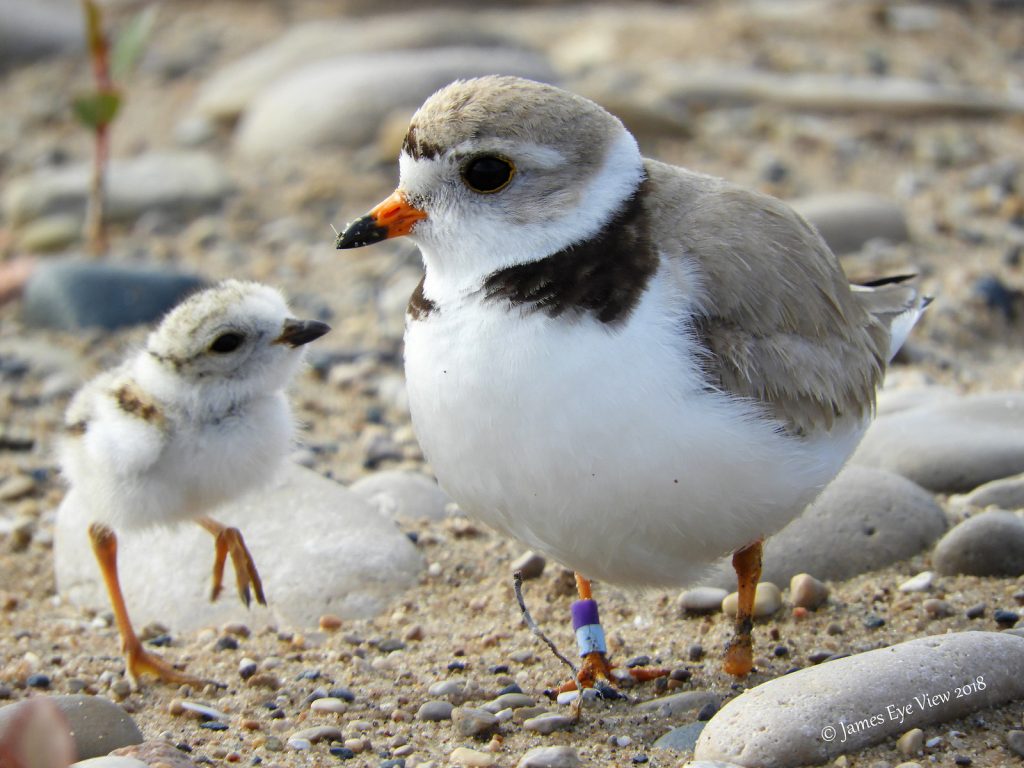
A bitter April wind blows across the sandy scrub of Napatree Point sending the wind chill into the twenties as a US Fish & Wildlife Service Wildlife Biologist and a group of volunteers try to warm themselves by pounding steel posts into the sand. The group, led by Maureen Durkin of the US Fish and Wildlife Service, are implementing the state and federal Piping Plover Conservation Plan by marking critical Piping plover nesting areas in the 86 acre Napatree Point Conservation Area. The Conservation area is managed by the Watch Hill Fire District and the Watch Hill Conservancy.
I hitch a ride, about a mile out, to the worksite on the bay side of Napatree in a four-wheel drive vehicle driven by Janice Sassi, the Napatree manager for The Watch Hill Conservancy. As the landscape goes by I’m reminded that Napatree Point once supported a large Spanish American War fort and later a colony of forty-two summer cottages but all that is gone now, abandoned or swept away by hurricanes. To the untrained eye this beautiful but desolate place would seem inhospitable to living things but during the summer months the sound of excited peeping gives evidence that, to the contrary, one of nature’s most fragile looking creatures calls this home. This diminutive shorebird is the piping plover.

Once on the brink of extinction the piping plover’s survival is a testament to the conservation work by a dedicated group of people. In Rhode Island the plover population was down to ten nesting pairs. There are only 2000 pairs left in the Atlantic Coast population and they are considered a threatened species under the Endangered Species Act.
Living on the edge is what these small shorebirds are all about. They only measure seven inches from beak to tail and migrate thousands of miles to nest here. They survive in spite of climate change and loss of habitat from development. They lay their eggs in shallow depressions scratched in the sand, their only defense against predators are the speckles on the eggs that camouflage them.
Maureen leads the plover conservation effort in Rhode Island, “I always really liked birds and wildlife. I went to Connecticut College and studied biology. After college, I had an internship with the Fish and Wildlife Service and that got me hooked on field work. After that, I had field jobs working with coastal birds and got interested in shorebirds. I went to graduate school at State University of New York, College of Environmental Science and Forestry and did my research on plovers in Florida. I worked mostly on the Gulf of Mexico for about eight years and I’ve been in the plover and shorebird world ever since. I came to Rhode Island for this position in 2019 and I really love it.”
Maureen’s office is located on Kettle Pond at the Rhode Island National Wildlife Refuge Complex in Charlestown. The US Fish and Wildlife Service manages five refuges in Rhode Island and also partners on management at off-refuge beaches like Napatree. “We have our piping plover program which is run cooperatively through a State Wildlife Grant with the Rhode Island Department of Environmental Management. This allows us to do piping plover management on off-refuge beaches. We work on beaches including Napatree, East Beach in Watch Hill, and state parks throughout South County. We have a lot of long standing partnerships in the community that are essential for doing conservation.”
Maureen spoke about the success they’ve had conserving plovers. “In the mid-eighties there were only ten nesting pairs left in the state. It’s taken thirty years but now we’re on the road to recovery and we’re up to eighty pairs. Most of that decline was because plovers like nesting on sandy beaches and those are the same areas where people like to recreate. The areas where we want to be are the same areas where the Piping Plovers need to make their nests and raise their young. Management and outreach help to make it work and avoid conflict. You can imagine if some of these areas weren’t protected there probably would be people over every inch of beach, making it difficult for plovers to nest here. It takes setting aside certain areas of the beach temporarily so their eggs aren’t crushed and their nests aren’t disturbed. We can have people using the beaches in a responsible way and plovers nesting there, you can do both.”
Today, the volunteers working with Maureen are made up of students from URI, many with courses that require internships in fieldwork. The Shorebird Crew Leader for the USFWS is Nicole DeFelice. She’s in her second year leading the volunteer crews. “I’ve worked with plovers in other places, like the outer banks of North Carolina, so I’m trying to follow them wherever they are. I love them.” I asked her if she was a plover groupie. “I love piping plovers. I get so excited every time I see one no matter if it’s the beginning of the season or the end. I love seeing them. We’re posting the nesting areas of the plovers out here to ensure that we protect their critical nesting areas before they arrive. Plovers are very habitual. They like to return to the same exact spot where they nested in previous years. It’s helpful to us because we know where to setup. We always hope that they return happy and healthy, that they want to use our habitats here. That it’s welcoming enough for them and they raise their young here successfully.”
As another load of steel posts and rope arrive and as the crew unloads, Maureen speaks about the contributions made by volunteers. “I think it’s important for the public to know that there have been so many dedicated volunteers, people who have come out and done postings and been out on the beach monitoring the birds and educating people. The birds wouldn’t be where they are today without these partnerships. It’s important to remember that the birds are just out here trying to do what people are trying to do. They’re trying to have a safe home, a safe place to be, trying to get food, raise their chicks, and come here every year and be successful. Then they fly back south. They’re trying to raise their families against a lot of odds; there are a lot of things out here that can eat a tiny egg or a tiny chick. They just need a little space to be able to do that and we can give them that and share the beach with them.”
Unlike songbirds, piping plovers and other shorebirds are called precocial. That means a few hours after the chicks hatch they get up out of the nest and they start running around and feeding themselves. The parent’s role is to lead them to good foraging areas and protect the chicks by leading predators away. They do this by acting injured with what’s called a broken wing display. Plover chicks have to grow to their full adult size in about 30 days and be able to fledge, which means they can fly. They have to almost constantly feed to be able to do this. If plovers are disturbed and kept from feeding frequently, it can make chicks slower to grow and less likely to fledge.
After posting the critical nesting areas the work is not done. “We’re really out here on shorebird duty all season working to monitor the plovers,” said Maureen. “We find and monitor nests, determine if they hatch or failed and why, and how many chicks fledged. Sometimes we put big circular cages called exclosures around the nests to keep predators out. The openings are big enough so the plover can get in and out to its nest but a fox, a coyote, or a crow can’t get in. Those have been instrumental in helping their survival.”
Plovers are important as an indicator species that allows scientists to get a glimpse of the condition of an ecosystem. “The presence of piping plovers is indicative of a healthy beach and a healthy environment,” said Maureen. “If our beaches can’t support native birds or native wildlife because they’ve been impacted by development or overuse, it’s not good. It’s really important to protect the birds, protect the beaches and these unique areas so they are around for future generations. And we can come out to places like Napatree and see these beautiful wild places and experience nature. There are only a few places left that are still intact like this so it’s really important to protect them and protect the birds that live here.”
For more information about the US Fish & Wildlife Service programs in Rhode Island you can visit their website at; https://www.fws.gov/northeast/maps/rhodeisland.html
If you’re planning to visit Napatree Point make sure to check out The Watch Hill Conservancy’s website; https://thewatchhillconservancy.org/
For The Watch Hill Conservancy’s educational programs for children visit; https://thewatchhillconservancy.org/napatree/napatree-investigators/
